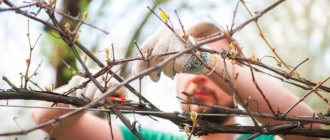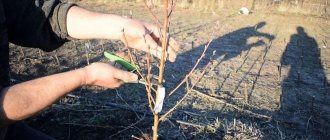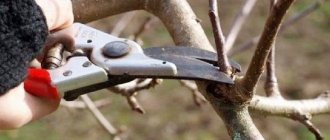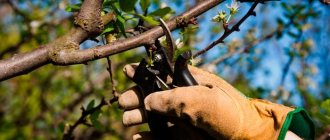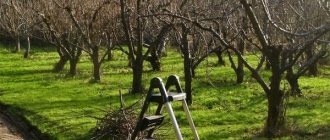Views: 725
Every summer resident grows raspberries on his own plot, but beginners are often faced with a lack of necessary knowledge. First you need to understand that raspberries bear fruit on two-year-old shoots, which die off immediately after fruiting. New young shoots grow intensively in the first year, and in the second year they begin to bear fruit. When properly pruning raspberries in the spring, you need to take into account the characteristics of the bush.
Usually, raspberry fruit buds begin to appear on the branches of the second year of life. Although there are special remontant varieties that are capable of producing a good harvest during the first year. But all varieties require renewal of shoots, since, starting from the 2nd year of growth, shoots may become sick and lose their previous ability to set fruit.
Expert opinion
Anton Markin
To get good fruiting, you need to know how to properly prune raspberries in the spring. The optimal height of raspberry shoots is considered to be 1.2-1.5 m. This height was determined based on the fact that the bulk of the fruit buds are concentrated in the central part of the stem. Therefore, the high height of the shoots impairs access to light.
At the same time, shortening the stems stimulates the direction of nutrients to the lateral branches. The raspberry flower is turned down. Thanks to this, the bee that extracts nectar works as if under a canopy, which means it can do this even during light summer rain. Bees, collecting nectar, are able to increase the yield of raspberries by 60-100%.
When to prune? Select month and timing
If winters are predominantly frosty and snowless, then spring pruning is carried out in March.
You should also not delay with autumn pruning. It is best to spend it in August-September. This procedure will help with the formation of replacement shoots and improve the lighting inside the bush, which will contribute to greater resistance to diseases and pests.
The most important thing is to prune 3 weeks before freezing temperatures set in.
How to prune raspberries correctly in spring?
Pruning raspberries is an important mission entrusted to the gardener. By carrying out a series of simple manipulations, you can ensure comfortable harvesting, and subsequently prevent the appearance of diseases and pests on raspberries that affect the bush. A few rules to help you:
- The best time for spring pruning is the end of March or beginning of April.
- Carry out pruning as soon as the snow melts, while the ground is still thoroughly saturated with moisture.
- When working, use special gardening tools that do not damage plants.
- The length of the remaining shoots should not exceed 50 cm. To ensure sufficient air circulation and access to light, it is permissible to leave no more than 30 branches per 1 square meter. m.
Be sure to consider how the raspberries were planted. With the bush method, no more than 5-6 branches are left on one plant. When using a trench, it is permissible to leave 14-15 branches.
After pruning, be sure to take care of the stems. Otherwise, this event will be ineffective. To preserve and strengthen the bush after pruning:
- cut off the shoots that are frozen at the base;
- for frozen ones, remove the damaged part;
- remove stems infested with insect pest larvae.
The video below provides a complete overview of pruning raspberries in spring:
Step trimming
The main goal is to extend the fruiting period. Divide the shoots into 4 parts and trim the raspberries according to this pattern:
- 1st part of the branches - shortened by 10-15 cm;
- 2nd part of the branches - shortened by 20-30 cm;
- 3rd part of the branches - shortened by 70 cm (50%);
- 4th part of branches - 3-5 cm remain.
This pruning method will significantly extend the raspberry harvest period. The juicy berry will delight the caring gardener until August. First of all, shoots shortened by 10-15 cm will begin to bear fruit, then the berries on the second part of the branches will begin to ripen, etc.
Pruning according to Sobolev
To stimulate active lateral branching, pinch the tips of the shoots. The best time for the procedure is May. To form 10-15 lateral shoots in the spring of the second year, shorten all overwintered shoots. This method increases the yield significantly, and in some cases allows raspberries to bear fruit a second time.
An important condition for successful double pruning is timeliness. You cannot delay the first stage; new shoots may not have time to become strong enough before the onset of cold weather.
The second stage will be carried out next year in May, when the leaves on the raspberries fully bloom. To do this, pinch last year's side shoots by 15 cm.
All these manipulations are necessary for the active growth of lateral branches - up to 15-20 pieces on one plant. When they all begin to bear fruit at once, the gardener’s efforts will be rewarded.
Carry out double pruning in stages:
- Trim off weak shoots.
- Trim the tops - this action is necessary for absolutely all shoots. To make the fruits large and juicy, cut 15-20 cm.
- Thin out the raspberry shoots. When the bush becomes dense, a lot of shoots grow on it, they begin to interfere with each other. Without thinning, they will not receive the required amount of substances necessary for development and growth. The bush will wither and will not bear fruit.
Sanitary pruning
Sanitary pruning fully lives up to its name. It is carried out both at the beginning of the season and at the end.
After waiting for the snow to completely melt, remove frozen and damaged shoots. At the first signs of plant awakening, remove the affected parts. In the fall, be sure to get rid of fruit-bearing branches.
Pinching the stems
Another way to increase raspberry yield is to pinch the stems. It is necessary to pinch not too early, but not later than June.
If you delay, you can seriously damage the plant, which is in the active phase.
Removing overgrowth
An overgrown bush does not guarantee a rich harvest; rather, on the contrary, it is a condition for its absence. Young growth that appears over time must be removed. The more extra shoots remain, the more light and air they will take away from the main bush, weakening and reducing yield.
You cannot pull out extra shoots from the ground or dig them up. This will lead to damage and disease to the plant. Carefully trim off all unnecessary growth close to the soil.
Pruning remontant varieties
The main goal of every gardener is a high yield. The main and most impressive difference between remontant varieties is that they are able to bear fruit more than once. Take this advantage into account when processing.
There are 2 types of pruning of remontant raspberries. The first one is for 1 harvest. This method is most often used for commercial cultivation. The result of the work will be only 1 harvest, but very abundant. For this:
- With the onset of the first frost, completely cut off all the bushes. It is impossible to prune earlier. Young growth germinating in warm weather will freeze.
- In early spring, carefully thin out young plants.
The second method is for 2 harvests. Considering that remontant varieties produce fruit on both annual and biennial shoots, pruning is carried out in 2 stages:
- After the first berry picking, trim off the two-year-old branches that bear fruit.
- When the second wave of fruiting has passed, carry out regular pruning. Then the annual stems will not dry out, but after overwintering, they will begin to branch and bear fruit.
Tree raspberry pruning
The second name for such raspberries is standard. It has strong branched branches, thereby looking like a small tree.
If you are not serious about growing such plants, you can end up with impassable jungle instead of a luxurious tree. Accordingly, this “wild” forest will not bear fruit.
Standard raspberries are regularly pruned. In this it is no different from other varieties. It is necessary to remove fruit-bearing shoots in a timely manner.
You can trim these raspberries using the double method. The best time to carry out the procedure is the end of May or the beginning of June. By this moment, the height of the plant will already reach 1 m. By the end of summer, about 5 side shoots will remain on the tree.
The second pruning is carried out already in the next season, in the middle or end of May. At this time, the side shoots are shortened by approximately 5-10 cm.
There is nothing complicated about caring for standard raspberries. The plant is unpretentious and produces a rich harvest. Along with ordinary raspberry varieties, it is very popular among gardeners.
Pruning raspberries for a good harvest from the bush
Some experienced gardeners resort to double pruning of raspberries, which allows them to increase the yield of the bush due to the formation of lateral fruiting branches. This procedure is carried out in early June. Annual shoots are pinched to 5 cm, removing the top. During the season, lateral buds awaken, which form additional branches. Next spring, all additional side shoots are cut back by 10 cm, which makes it possible to get a good harvest from them.
Any novice gardener needs to remember that this procedure must be carried out. The main rule is to avoid thickening the raspberries. Regular sanitary thinning of the bush increases the yield, prolonging fruiting, and allows you to grow healthy raspberries.
Recommendations for caring for trimmed raspberries
Below are recommendations for caring for raspberries after pruning. You need to know how to apply fertilizing, disinfect shoots and tie raspberries to a trellis. All this will help you get a richer harvest.
The gardener in his video talks about caring for raspberries after pruning:
Introduction of fertilizing
March is best for applying the first fertilizing. Depending on the composition and condition of the soil, gardeners use various fertilizers.
If the soil is relatively balanced, then any universal complex fertilizer will be suitable as the first fertilizing. Things are different in problem areas. For example, if raspberry leaves turn yellow, it means the soil in which it grows does not have enough nitrogen. Then saltpeter diluted in water is additionally added.
The next important period in which it is worth paying special attention to the condition of plants is the period of flowering and fruit set. At this time, the second feeding is carried out, its purpose is to strengthen the bush at the moment of formation of the ovary. A mixture of potassium sulfate and superphosphate in certain proportions is ideal.
Gardeners carry out the last, third feeding in the fall, after cutting the shoots. To implement it, you will need the same fertilizers as for the second feeding, only in smaller quantities.
Don’t forget about organic fertilizers, without which not a single variety of raspberry can do. However, like any other fruit-bearing shrubs. You need to fertilize the soil with organic matter very carefully.
This is done no more than 1-2 times every 3 years. Any manure that the gardener has will do.
Disinfection of shoots
As soon as the first buds on the raspberries begin to wake up, they should be treated against numerous insects and diseases.
Bordeaux mixture is a panacea in the fight against these scourges. At the very beginning of spring, plants are necessarily sprayed with a one percent solution. To avoid infection from neighboring plantings, they are also treated together with raspberry bushes.
Spraying is repeated a little later, when the buds finally wake up. At the time of active flowering and fruit formation, the raspberry tree is carefully inspected and the affected parts, if any, are removed.
To prevent insect larvae from remaining on the plants and going into the soil for the winter, in the fall, after the last harvest is harvested, a final treatment with Bordeaux mixture should be carried out.
Why gardeners are fighting raspberry shoots
For planted plants, this phenomenon is similar to weeds,
because:
- also takes away from the main culture the useful elements it needs.
- In this case, gardens become unkempt and attract many harmful insects;
- It is difficult to get to the lower tier of the berry garden for maintenance.
If the raspberry fields are clean, then the crop receives good development and fruiting, because it is provided with a lot of sun and fertilizing.
It is blown by the winds and therefore is less susceptible to various types of infections. Harvesting is also easier with such well-groomed plantings. Therefore, it is necessary to remove root shoots.
Every year one rhizome produces 3-30 offspring. Of course, not everything is removed, otherwise the harvest will be lost. But if the cutting is done correctly, then it can be increased even 2 times.
More on the topic: New early ripening raspberry variety Koldunya
Rejuvenation of an old raspberry tree
You can grow raspberries in one place for a limited time. The optimal period is from 10 to 18 years, depending on the composition and condition of the soil. Over time, the soil becomes depleted, productivity decreases, and the bush begins to hurt.
There comes a time when it’s time to rejuvenate the raspberry tree. It is better to start doing this in the fall.
The main essence of rejuvenation is the gradual methodical removal of weakened old bushes. To do this, carefully remove old plants by cutting off the roots.
Fill the remaining holes with nutritious soil and water. Next spring, do not forget to feed the entire area of the raspberry tree with fertilizer.
Biennial shoots of bushes will bear fruit this season. New shoots will appear in the fall in place of the old ones. A year later, replacement shoots will appear, which after another 1 year will begin to bear fruit. As a result, there is no complete lack of harvest, but a completely new shrub appears nearby.
Tying raspberries to a trellis
As noted above, the features of caring for raspberries depend on the method of their initial planting. Trellis garter is perfect for shrubs planted using the trench method.
Raspberry is a tall shrub. Garter is a necessary condition for its successful cultivation, because the shoots of the plant are quite thin and flexible.
They often cannot support their own weight and bend low to the ground. Because of this, raspberry fruits are often affected by rot. Only low-growing varieties of shrubs can be grown without garter. Everyone else needs this event.
Raspberry trellis has many advantages:
- With the help of trellises, beautiful beds can be formed without any problems.
- Lower branches, leaves and berries do not get dirty. They are not afraid of slugs, snails and frogs.
- The trellis method of gartering helps to form straight beds with free spaces. This arrangement promotes good air circulation and sufficient sunlight, which, in turn, prevents the possibility of fungal diseases.
- Access to plants remains free, making them much easier for gardeners to care for.
- Harvesting, as well as preparing for winter, is not difficult.
The structure is assembled on site like this:
- On both sides of the row with bushes, install poles secured to posts.
- Tie the plant stems to the supports. For example, this can be done using twine. This trellis is completely simple to manufacture, but its design can be improved. As in the first option, install the support on one side of the row with the bushes, but not on the edge, but at a distance of 30-40 cm from it.
- Tilt the branches towards the trellis, then fix them in this position. Now the adult shoots will not interfere with the growth and development of the young ones, which will have a beneficial effect on the condition of the raspberry tree.
Fighting weeds mechanically
Raspberry shoots are easily removed when they are young, or they are prevented from growing at all with the help of protective barriers. They are arranged with a width of 40-50 cm and a depth of 35-40 cm.
This will be enough to limit the emergence of root shoots. Because their root systems are only 25 cm lower from the surface of the earth.
Also for cultivation and limiting growth, for culture, they prepare car tires, buried barrels, and buckets without bottoms.
And they try to immediately remove all unnecessary vegetation by digging and removing root shoots. Then cover the areas with mulch.
After 2-3 weeks, the layer is removed, and the soil is dug up again and the regrown roots are collected. Experienced gardeners do not cut them out, because they will grow even more.
Important! The shoots can even be cut with a shovel; they will dry out after a while. And, of course, you need to regularly weed the berry rows.
Mistakes that cost gardeners their harvest
Only those who do nothing make no mistakes. Gardening is no exception to this rule.
The most common mistakes:
- Reluctance to trim strong growth. Many people believe that by removing it, they are ruining the harvest in advance. It is worth remembering that without proper pruning, the raspberry tree will become sick, the berries will become small, and there will be no harvest at all.
- The shoots to be pruned are removed only superficially. Young gardeners often start pruning from the outer branches. Young shoots are removed, but only the outermost shoots are cut out, without climbing inside the bush. As a result, the raspberry tree grows excessively, yields drop, and diseases appear.
- The intertwined branches are left. If branches in contact with each other are not trimmed in time, the risk of plant disease will significantly increase.
- Incorrect trimming. Some gardeners do not trim the shoots, but only shorten them slightly. Remove dry branches and leave everything else. But just sanitary pruning is not enough. Regular shaping is definitely needed, on which the quality and quantity of the future harvest directly depends.
- Buds are damaged when pruned. Inept hasty actions easily lead to disastrous results. To prevent this from happening, you need to strictly follow the pruning scheme that has proven itself over the years. Initially, the largest branches are removed, then the smaller ones.
Answers to frequently asked questions
How to choose the right scheme?
For beginning summer residents, it is necessary to opt for removing old shoots and shortening young ones. For those who have already experienced pruning, you can use the double pruning method in July.
How often can young growth be removed?
In order for the raspberry tree to have a neat appearance, young growth can be removed as it appears. If you let the young growth grow too much, it will lead to severe thickening, and it will be problematic to tidy up the raspberry field.
Timing of pruning in different climatic zones
Differences in raspberry pruning techniques are determined by climatic conditions:
- In the central regions of the Russian Federation and in the Moscow region , you don’t have to cut off young shoots for the winter. In order for the shrub to quietly overwinter, it is enough to tie and cover its shoots. The best natural insulation in this case is snow.
- Autumn pruning in Siberia is a mandatory event. The climate here is harsh, winters are cold. Therefore, it is much easier to carefully cover a trimmed shrub, preserving it until the spring thaw.
- Gardeners in the Krasnodar region begin pruning raspberry trees only in late autumn. Thanks to climatic conditions, they have time to harvest one more late harvest. Although autumn raspberries are smaller, and there are very few in quantity, their mere presence prolongs the feeling of summer and gives joy.
Raspberries are unpretentious and bear fruit under any conditions. But, if you want to get a good harvest, it needs care both in autumn and spring. One of the most important conditions for growth and high yield is timely pruning.
0
0
Copy link
Why do this
Pruning raspberries is an opportunity to control the internal processes occurring in the plant. Thanks to the procedure, the juices are redistributed in the branches, allowing the formation of large fruits. The types of pruning are determined by its purposes.
- Formative. Primary pruning is carried out immediately after planting, followed by every summer and spring. The purpose of the procedure is to form a neat bush of a certain height.
- Sanitary. Aimed at improving the health of the bush. During the spring inspection, all shoots that did not survive the winter (frozen, rotten, broken) are removed. In autumn and summer, diseased and dry stems are cut out.
- Thinning. Pruning is carried out throughout the growing season. Excess shoots are cut off at the root, taking on the nutrients needed by the fruit bearings.
- Preparatory. The procedure is carried out half a month before the onset of frost. Completely remove fertilized branches and shoots that appeared in the summer.
Also pruning raspberries can be:
- Seasonal;
- For reproduction;
- According to the Sobolev method;
- Characteristic of remontant varieties.
We won’t miss anything, we’ll talk about each method...
Read: Top 12 northern berries with names, descriptions and photos
